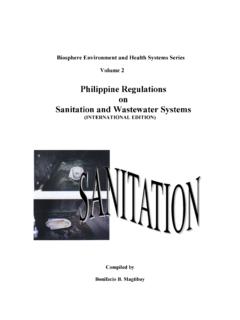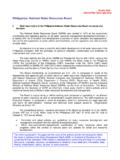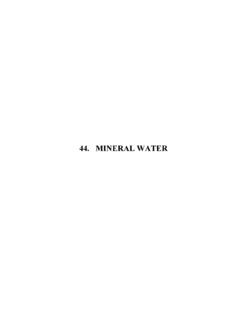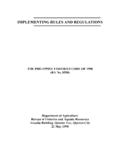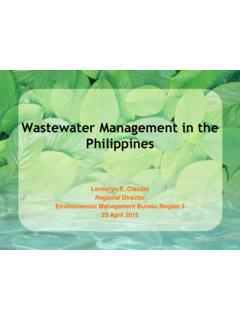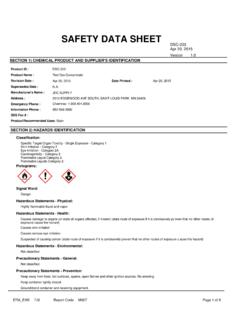Transcription of REVISED IRR OF MINING ACT OF 1995 - Armand …
1 HIGHLIGHTS OF THE MINING ACT OF 1995 (RA 7942) AND ITS REVISED IMPLEMENTING RULES AND REGULATIONS The Philippine MINING Act of 1995 and its REVISED Implementing Rules and Regulations (RIRR) is considered in the industry today as one of the most socially and environmentally-sensitive legislations in its class. It has specific provisions that take into consideration: Local government empowerment; Respect and concern for the indigenous cultural communities; Equitable sharing of benefits of natural wealth; Economic demands of present generation while providing the necessary foundation for future generations; Worldwide trend towards globalization; and Protection for and wise management of the environment. These were the products of long periods of assessment, evaluation, and rectification of the sins of the past, the gaps of the old MINING law, and the realities of the present times. GOVERNING PRINCIPLES The Implementing Rules and Regulations (DENR Administrative Order ) of the Philippine MINING Act of 1995 provides strict adherence to the principle of SUSTAINABLE DEVELOPMENT.
2 This strategy mandates that the needs of the present should be met without compromising the ability of the future generations to meet their own needs, with the view of improving the quality of life, both now and in the future. Sustainable development provides that the use of mineral wealth shall be pro-people and pro-environment in sustaining wealth creation and improve quality of life. The principles of SUSTAINABLE MINING operates under the following terms: MINING is a temporary land use for the creation of wealth, leading to an optimum land use in post- MINING stage as consequence of progressive and engineered mine rehabilitation works done in cycle with MINING operations; MINING activities must always be guided by current Best Practices in environmental management committed to reducing the impacts of MINING while efficiently and effectively protecting the environment. The wealth created as a result of MINING accruing to the Government and the community should lead to other wealth-generating opportunities for people in the communities and for other environment-responsible endeavors.
3 MINING activities shall be undertaken with due and equal regard for economic and environmental considerations, as well as for health, safety, social and cultural concerns. Conservation of minerals is effected not only through technological efficiencies of MINING operations but also through the recycling of mineral-based products, to effectively lengthen the usable life of mineral commodities. The granting of MINING rights shall harmonize existing activities, policies and programs of the Government that directly or indirectly promote self-reliance, development and resource management. Activities, policies and programs that promote community-based, community-oriented and procedural development shall be encouraged, consistent with the principles of people empowerment and grassroots development. ORGANIZATIONAL IMPLEMENTATION The MINING Act reverts back the Mines and Geosciences Bureau (MGB) from a Staff to a Line Bureau.
4 Under this arrangement, the MGB Central Office has now the administrative jurisdiction and responsibility over its regional offices. The Line Bureau structure was contemplated to ensure organizational efficiency and flexibility in managing limited resources and technical expertise. The authorities/responsibilities of the MGB are as follows: Management and administration of mineral lands and resources, including the granting of MINING permits and mineral agreements; Enforcement and monitoring of Environmental Work Programs (EWP) and Environmental Protection and Enhancement Program (EPEP); Establishment and operationalization of the Contingent Liability and Rehabilitation Fund (CLRF), as well as the mandatory Final Mine Rehabilitation and Decommissioning Plan; Cancel MINING applications and MINING rights violating the provisions of the MINING Act, its implementing rules and regulations, and/or the terms and conditions of a MINING permit/contract/agreement; For the Regional Directors to impose Cease-and-Desist Orders (CDO); To deputize the PNP, LGUs, NGOs and other responsible entities to police MINING activities.
5 To assist the Environmental Management Bureau (EMB)/DENR Regional Offices in processing/evaluation/conduct of EIA in MINING projects; To manage and administer Mineral Reservation area (Note: Mineral Reservations, under the New Act, include offshore marine areas.) ROLE OF LOCAL GOVERNMENTS The IRR highlights the role of local government units (LGUs) in MINING projects, both as beneficiaries and as active participants in mineral resources management, in consonance with the Constitution and government policies on local autonomy and empowerment. As such, the MINING Act provides the following: In consonance with the Local Government Code of 1992 (LGC), LGUs have a share of forty percent (40%) of the gross collection derived by the National Government from MINING taxes, royalties and other such taxes, fees or charges from MINING operations in addition to the occupational fees (30% to the Province and 70% to the Municipalities concerned); In consonance with the LGC and the People Small-Scale MINING Act (RA 7076), the LGUs shall be responsible for the issuance of permits for small-scale MINING and quarrying operations, through the Provincial/City MINING Regulatory Boards (PMRBs/CMRBs); To actively participate in the process by which the communities shall reach an informed decision on the social acceptability of a MINING project as a requirement for securing an Environmental Compliance Certificate (ECC).
6 To ensure that relevant laws on public notices, consultations and public participation are complied with; To participate in the monitoring of MINING activities as a member of the Multipartite Monitoring Team, as well as in the Mine Rehabilitation Fund Committee; To act as mediator between the Indigenous Cultural Communities (ICCs) and the MINING contractor as may be requested/necessary; To be the recipients of social infrastructures and community development projects for the utilization and benefit of the host and neighboring communities; and To coordinate with and assist the DENR and the MGB in the implementation of the MINING Act and the IRR. AREAS CLOSED TO THE MINING APPLICATION Pursuant to the MINING Act of 1995 and in consonance with State policies and existing laws, areas may either be closed to MINING operations, or conditionally opened, as follows: Areas CLOSED to MINING applications: Areas covered by valid and existing MINING rights and applications; Old growth or virgin forests, mossy forests, national parks, provincial/municipal forests, tree parks, greenbelts, game refuge, bird sanctuaries and areas proclaimed as marine reserve/marine parks and sanctuaries and areas proclaimed as marine reserve/marine parks and tourist zones as defined by law and identified initial components of the NIPAS, and such areas as expressly prohibited thereunder, as well as under DENR Administrative Order No.
7 25, s. 1992, and other laws; Areas which the Secretary may exclude based, inter alia, or proper assessment of their environmental impacts and implications on sustainable land uses, such as built-up areas and critical watershed with appropriate barangay/municipal/provincial Sanggunian ordinances specifying therein the location and specific boundaries of the concerned area; and Areas expressly prohibited by law. The following areas may be opened for MINING operations, the approval of which are subject to the following conditions: Military and other government reservations, upon prior written consent by the government agency having jurisdiction over such areas; Areas near or under public or private buildings, cemeteries, and archaeological and historic sites, bridges, highways, waterways, railroads, reservoirs, dams and other infrastructure projects, public or private works, including plantations or valuable crops, upon written consent of the concerned government agency or private entity, subject to technical evaluation and validation by the MGB; Areas covered by FTAA applications, which shall be opened, for quarry resources upon written consent of the FTAA applicants/contractors.
8 However, MINING applications for sand and gravel shall require no such consent; DENR Project areas upon prior consent from the concerned agency. ANCESTRAL LANDS AND ICC AREAS The MINING Act fully recognizes the rights of the Indigenous Peoples (IPs)/Indigenous Cultural Communities (ICCs) and respect their ancestral lands. Thus, in accordance with DENR Administrative Order No. 2, and consistent with the new Indigenous Peoples Rights Act (IPRA), the following shall be observed: No mineral agreements, FTAA and MINING permits shall be granted in ancestral lands/domains except with prior informed consent in: a) CADC/CLC areas; and b) areas verified by the DENR Regional Office and/or appropriate offices as actually occupied by Indigenous Cultural Communities under a claim of time immemorial possession; Where written consent is granted by the ICCs, a royalty payment shall be negotiated which shall not be less than 1% of the Gross Output of the MINING operations in the area.
9 This Royalty shall form part of a Trust Fund for socio-economic well being of the ICCs in accordance with the management plan formulated by the ICCs in the CADC/CALC area. (In a large-scale MINING operation the 1-% Royalty could easily run into several tens of million pesos per year). Representation in the Multi-partite Monitoring Committee; SOCIAL AND COMMUNITY DEVELOPMENT AND RESEARCH AND DEVELOPMENT The MINING contractors/operators shall allocate a minimum of 1% of their direct MINING and milling costs for the following: Development of the host and neighboring communities and mine camp, including the construction and maintenance of social infrastructures to promote the general welfare of the inhabitants in the area. Such infrastructures include roads and bridges, school buildings, churches, recreational facilities, housing facilities, water and power supplies, etc.; For the development of MINING technology and geosciences, particularly those related to improved efficiencies and environmental protection and rehabilitation; The MINING contracts under the regimes of MPSA and FTAA also provide for the mandatory Filipinization program, technology transfer, and the training and priority employment of local residents.
10 These contracts further mandate that MINING operations shall maximize the utilization of local goods and services, the creation of self-sustaining generating activities, and skills-development. ENVIRONMENTAL AND SAFETY CONCERNS A significant feature of the MINING Act of 1995 and its IRR is the premium given to environmental protection. Stringent measures were institutionalized to ensure the compliance of MINING contractors/operators to internationally accepted standards of environmental management. On top of the ECC conditionalities, herewith are some of the highlights provided for in the IRR; Mandatory allocation of an approximately 10% of the initial capital expenditures of the MINING project for environment-related activities; Mandatory annual allocation of 3-5% of the direct MINING and milling costs to implement an Annual Environmental Protection and Enhancement Program; Mandatory establishment of a MINE REHABILITATION FUND (MRF) to be composed of: a) a Monitoring Trust Fund of P50,000 which is replenishable; and b) a Rehabilitation Cash Fund of P5 Million or 10% of the EPEP cost, whichever is lower.
